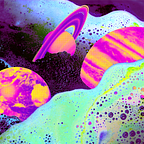Colonial Shaming and Forced Tattoos: The Dark Side of India’s Inked History
The move to revitalise the country’s ancient tattoo traditions is born from a feeling of cultural pride and rebellion.
“Throughout history, tattoos in India have had different purposes, ranging from beautification of the body to acting as a protection against bad spirits.”
Tattooing has a long history in India — hundreds, if not thousands of years old, yet it’s hardly been studied. No one can say exactly when the tradition started, but we know it ended (or began to decline) with colonialism. Luckily there’s been a resurgence in the Indian youth today, but in general, Indians have internalised the colonial shaming they received and public opinion of body art is firmly in the disdain and taboo camp.
“Settlers and missionaries imposed their beliefs of modesty and Christianity on the areas where they ruled, and tattoo culture slowly died away. They called this process of killing off cultures and practices ‘modernisation’. Tattoos changed from being an expression of pride in community and identity to being a marker of an era gone by,” according to Zora.
Symbols of status, coming of age, beautification and protection soon became the exact opposite. “For ages, tattoos in Indian culture were worn to symbolise status or community,” the blog continues. “Different tribes across the country used ink of varying colours, and tattoos were placed on different parts of the body depending on gender. As traditions began to fade, so too did the reverence for body ink, with some in Indian cultures coming to view tattoos as unacceptable and undesirable.”
In parts of India, tattooing was like jewellery – jewellery that couldn’t be stolen. “For hundreds of years, the tradition of tattooing was venerated across the agrarian and forested landscapes of India,” according to The Better India. “The ancient maze-like carvings on prehistoric rocks were copied by tribal communities on their bodies. They called the process gudna (‘burying the needle’ in Hindi) and flaunted the markings as jewellery – the kind of jewellery no one could take away from them, even if they were to lose all their worldly possessions.”
And yet, there is a darker side to India’s tattoo history – some villages practiced forcible tattooing on young girls as a form of control and oppression. “In the past, if a woman did not have a tattoo, she used to be seen as impure and untouchable,” according to Accidental Factory. “They would get a tattoo after getting married... Tattoos would also be done to indicate a girl was part of a certain tribe, after she turned 10 years old, or after giving birth. It is estimated that millions of women were tattooed forcefully throughout their lives.”
Also in certain tribes, tattooing was practiced as a way of deliberately making women less attractive: “In the North-centre of India, the Danuks believe tattoos reduce the attractiveness of women, thus making sexual predators less interested in them,” the blog states. “The same is true for the Apatani, another tribe that inhabits the north of the country. This tribe tattooed young girls to make them look less attractive in the eyes of neighbouring tribes that would otherwise be more likely to abduct them.”
The practice of tattooing young girls’ faces — using “rudimentary methods” and no anaesthesia — was judged to be particularly abhorrent and it was banned by the Indian Government in the 1970s. Today, the move to revitalise India’s ancient tattoo traditions is born out of a feeling of cultural pride and rebellion, and the desire to subvert misogyny by women reclaiming tattooing for themselves: “Body art for an Indian woman can be a symbol of liberation and a rejection of oppressive and limiting rules,” according to Zora.
Journey through tattoo history at NAAMA’s Medium — our space to explore the ever-changing human relationship to tattoos, chronicle their complex history, and celebrate the empowering future of body art evolution.
